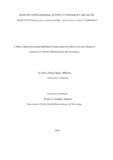| dc.description.abstract | Malaria continues to cause heavy morbidity and mortality and it is the fifth leading cause of
death globally. The disease causes over one million deaths annually and affects many more,
particularly due to increasing multi-drug resistant strains of Plasmodium falciparum.
Sustained investigations in both curative and prophylactic interventions have supported the
ethno-pharmacological approach to identify novel compounds as a major channel towards
achieving a solution. The medicinal plants Zanthoxylum chalybeum and Vernonia lasiopus
are traditionally used for the treatment/prophylaxis of malaria by some of the local
communities in Kenya. The aim of this study was to evaluate antiplasmodial activity and
safety of the two selected plants. Their activity on combination was also investigated.
Zanthoxylum chalybeum leaves, stem bark, root bark and Vernonia lasiopus aerial parts and
roots were collected and extracted with methanol: dichloromethane (1:1) solvent mixture.
The resulting crude extracts were each fractionated into six fractions by vacuum liquid
chromatography using solvents of different polarities, and investigated for antiplasmodial
activity (IC50) using the chloroquine (CQ) sensitive D6 and chloroquine (CQ) resistant W2
laboratory adapted Plasmodium falciparum strains. The safety profile was done by
determining the in vitro cytotoxicity (CC50) on Vero 199 cells using the MTT based
colorimetric assay and in vivo median lethal dose (LD50) in mice. The selectivity index
(CC50/IC50) was used as an indicator of their antiplasmodial viability.
The results showed that Z. chalybeum roots fraction 6 and Z. chalybeum stem bark fraction 6
are highly active and active respectively with IC50 values of 0.78 0µg/ml and 6.0µg/ml
against the P. falciparum D6 strain. They had selectivity indices of >128.21and >16.67
respectively, and LD50 values of >5000mg/kg indicating safety. V. lasiopus crude root extract
showed the most promise at IC50 of 13.1 µg/ml against D6 strain, with selectivity index >
7.63 and LD50 >5000mg/kg.
Extracts of both Z. chalybeum and V. lasiopus were found to have antiplasmodial activity and
favourable safety profile with the highly active Z. chalybeum roots fraction 6 being the most
viable sample. Further chemical analysis is recommended for this fraction and the active
samples, and they will hopefully be used as candidates for development as anti-malarial
medicine. The crude roots extracts of the plants showed activity (IC50) of 1.11 µg/ml and 13.1
µg/ml respectively and this supports their use traditionally. Some samples classified as active
also had good safety margin and may also be explored further. Detailed combination studies
of the various samples may be carried out to as they may bear different pharmacologic
properties whose interactions could result in beneficial outcomes such as potentiated activity
and curtailing resistance.
Key words: Plasmodium falciparum, Z. chalybeum, V. lasiopus, fractions, selectivity index,
LD50. | en_US |

